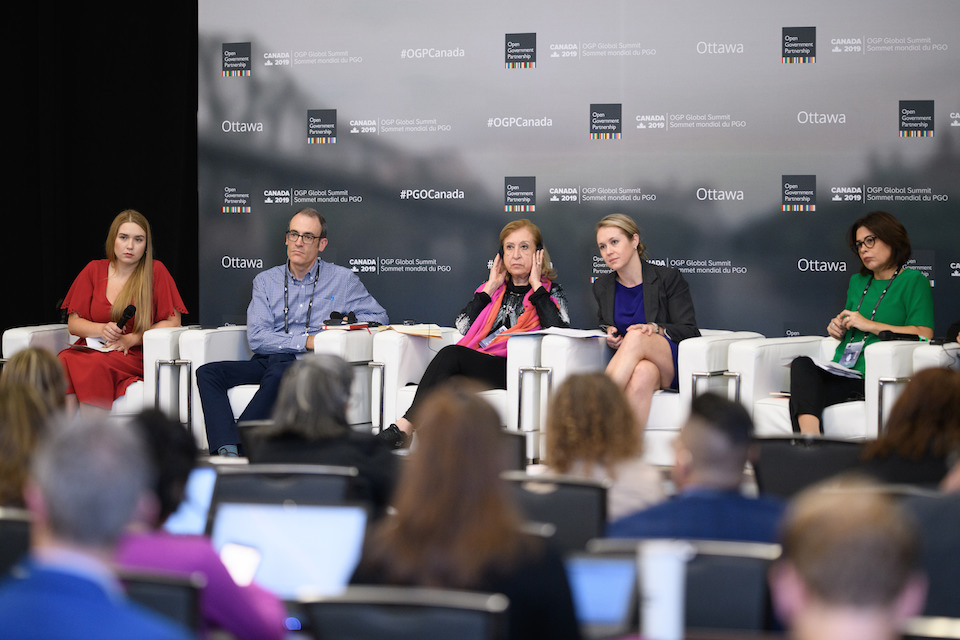How is gender mainstreaming in open government policies possible?
Published 8 July 2019
Reflections and learnings from the session run by the Data Policy, Strategy & Ethics team from the Department for Digital, Culture, Media & Sport during the 6th Open Government Partnership Global Summit in Ottawa, Canada (29-31 May 2019).

Gender mainstream panel
1. How can we ensure that gender informs the design of Open Government Partnership (OGP) commitments and action plans, and that we address gender inequality in open government?
-
Embed intersectional[footnote 1] engagement processes and conduct inclusion reviews when working on the National Action Plans (NAPs) for Open Government. This can include planning citizen engagement and considering factors that might influence participation, such as timing, accessibility, location within the country (e.g. rural areas). For instance, in order to develop the Canadian NAP, consultations were held in 17 cities across the country, through open.canada.ca, and reddit, engaging 10,000 Canadians. Despite the extensive engagement and multistakeholder forum, findings from the inclusion review conducted afterwards were mixed. Four external reviewers were asked to go through the NAP to come up with indicators for the inclusion of traditionally disengaged groups, which helped the government understand how these dynamics work in practice. For instance, the time of day of the consultation can determine what groups are or aren’t able to attend and this should be taken into consideration when designing inclusive and participatory policy exercises
-
In order to mainstream gender in OGP commitments, we need to go beyond the NAP. Open Data is now the standard way of working for many governments. Governments now need to embrace a non-binary approach to develop long-lasting standards that work beyond 2 year cycles
-
Use design and research methods that address problems pertaining to gender, age, culture, race, etc. For example, Design Justice Network use collaborative creative approaches to address issues in society; ID for Change has written about how policy needs to change to reflect communities on the margins of the national mainstream; Open Data Labs Jakarta use data to advance the gender agenda
-
Share learnings and exchange best practice with other countries - as the OGP process facilitates international collaboration, it’s important to use it as a platform to learn from others
2. What can we do if we already have a National Action Plan that doesn’t have gender-focused commitments, but instead of waiting for the new National Action Plan, we would like to start implementing our current commitments in a gender-focused manner?
-
Try to apply the gender and intersectional lens throughout the remaining process of implementation of the NAP, for instance through mid-term inclusion reviews
-
Canada has written a guide to Gender-Based Analysis +, which suggests options and examples for countries looking to be more inclusive beyond specific commitments
-
Look at the data that governments make available from a more intersectional perspective. Disaggregation of data is one of the biggest issues - in most cases, binary sex categories are the basis, which makes it hard to think about specific policy decisions
-
Build inclusive open government institutions - encourage participation and create open government role models and leaders from minority groups
-
Strongly monitor the implementation of action plans, engage citizens in the evaluation process, and introduce feedback loops and milestones using a multi-channel approach to complement official reporting and ensure that the plans work for everyone. Multi-channel approaches can help confirming feedback through different channels and stages
3. How do we think beyond gender and put people with all of their complexities at the centre of decisions?:
-
To ensure true representation, take into account the audience you’re speaking with and their specific needs and differences, e.g. rural and urban communities
-
Open the government for everyone, including the groups with limited access. Find intermediaries and infomediaries who can reach out to people with limited or no understanding of data and digital, ensure to include their perspective and to explain how the information they provide in the consultation process will be used
-
Avoid jargon - pay attention to the choice of words and communication methods; write in a simple, accessible way, e.g. in plain english rather than using specific policy terms
-
Find ways to communicate ideas and their consequences better, for instance, run open government mapping exercises with stakeholders outside of the usual circle
-
Use examples and storytelling to make your message clearer and more accessible
Speakers:
● Jaimie Boyd, Director of Open Government, Treasury Board of Canada Secretariat, Canada
● Silvana Fumega, Research and Policy Director, Iniciativa Latinoamericana de Datos Abiertos, Argentina
● Ana Brandusescu, Independent Data Consultant, United Kingdom
● Nathaniel Heller, Civil Society Co-Chair of OGP Steering Committee & Executive Vice President, Results for Development, United States
● Soukeina Bouraoui, Director, Centre of Arab Women for Training & Research, Tunisia
Moderator:
● Natalia Domagala, Department for Digital, Culture, Media & Sport, United Kingdom
This is an open discussion led by DCMS and our government and civil society partners, not an official statement of policy.
-
Intesectionality can be defined as the complex, cumulative way in which the effects of multiple forms of discrimination (such as racism, sexism, and classism) combine, overlap, or intersect especially in the experiences of marginalized individuals or groups). ↩
